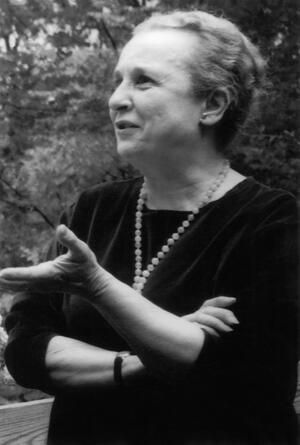Esther Hautzig
I started working at the Central Children's Room at the Donnell Branch of NYPL around four years ago. While working there I often spoke with author Esther Hautzig, an author and volunteer who dedicated much of her time and energy to the place. Esther was lovely, and I understood her to be an author. What I did not understand was her history, and how it informed her work over the years.
At the age of nine, in 1939, Esther and her family were put on a deportation train by the invading Russian army and shipped to Siberia. This later appeared in her memoir for children, The Endless Steppe. After that she was sent to America and eventually ran the publicity and library services department for the Thomas Y. Crowell Company back in the '50s and 60s. She wrote even more and she died at the age of 79.
As one friend of mine said, "She is the kind of person who'll never appear in a history of publishing but contributed so much to the children's books field when it was all librarians and retailers had not yet reared their ugly, Mammon-worshipping, heads."




the book was good
Could you add a little bit more to the information?
What a wonderfully written book The Endless Steppe is! My grandsons will be reading it, as the will be getting it as an "Oma present" when I visit. It is a corner of WWII history many are unaware of, as the Polish "capitalist class" deportees of the Russian occupation prior to the Nazi takeover were, as Esther puts it, "saved by our exile." Ever intelligent, resourceful and inquisitive, Esther's family members manage to make their sojourn in Siberia a generative, life-affirming time. Hence, Esther's memoir has a universal message beyond merely recounting her life.
I was wondering if you could please add what awards and the amount Esther Hautzig has won and what she won them for please i am so sorry to be that person but i was really wondering because i have to write a biography on it and haven't been able to find anything on it all day keep in mid i have been up for abot23 hours working on it and it is due on Monday and i am so sorry if that sounds really mean or really rude and i am so sorry i have to be this person about this but have a good day and please tell/text/dm me if you can find a source that has that iformation. on it
What a wonderfully written book The Endless Steppe is! My grandsons will be reading it, as the will be getting it as an "Oma present" when I visit. It is a corner of WWII history many are unaware of, as the Polish "capitalist class" deportees of the Russian occupation prior to the Nazi takeover were, as Esther puts it, "saved by our exile." Ever intelligent, resourceful and inquisitive, Esther's family members manage to make their sojourn in Siberia a generative, life-affirming time. Hence, Esther's memoir has a universal message beyond merely recounting her life.
Ì¢âÂÒI read in the NYTimes obituary that the inspiration for her most famous book, "The Endless Steppe," came from Adlai Stevenson of all people. Apparently he wrote articles about his visit to Rubtsovsk, the Siberian city where Mrs. Hautzig, her parents and a grandmother had spent the war. When she read the articles, she wrote to Stevenson, and he urged her to turn her memories into a book.
Ì¢âÂÒI read in the NYTimes obituary that the inspiration for her most famous book, "The Endless Steppe," came from Adlai Stevenson of all people. Apparently he wrote articles about his visit to Rubtsovsk, the Siberian city where Mrs. Hautzig, her parents and a grandmother had spent the war. When she read the articles, she wrote to Stevenson, and he urged her to turn her memories into a book.